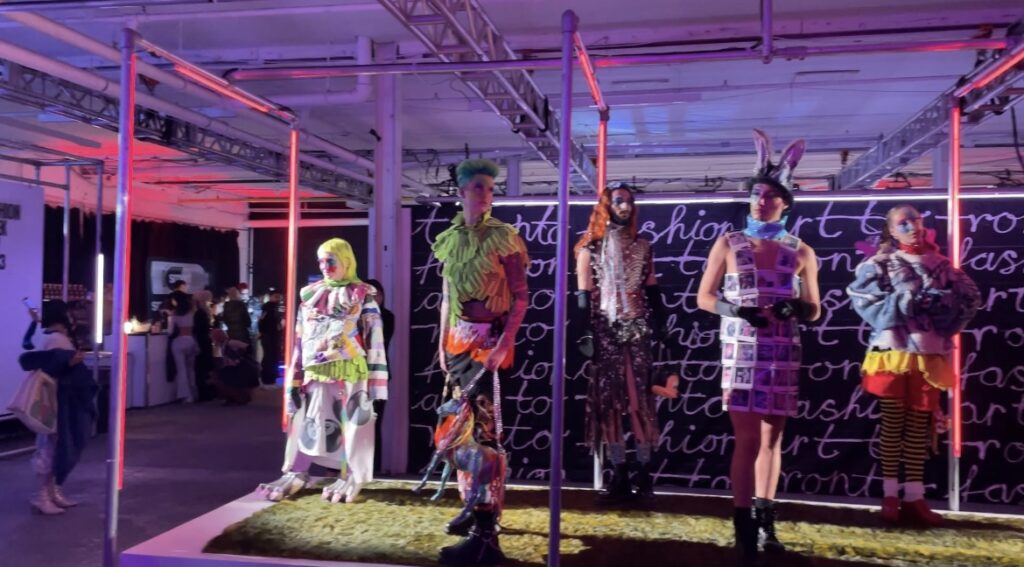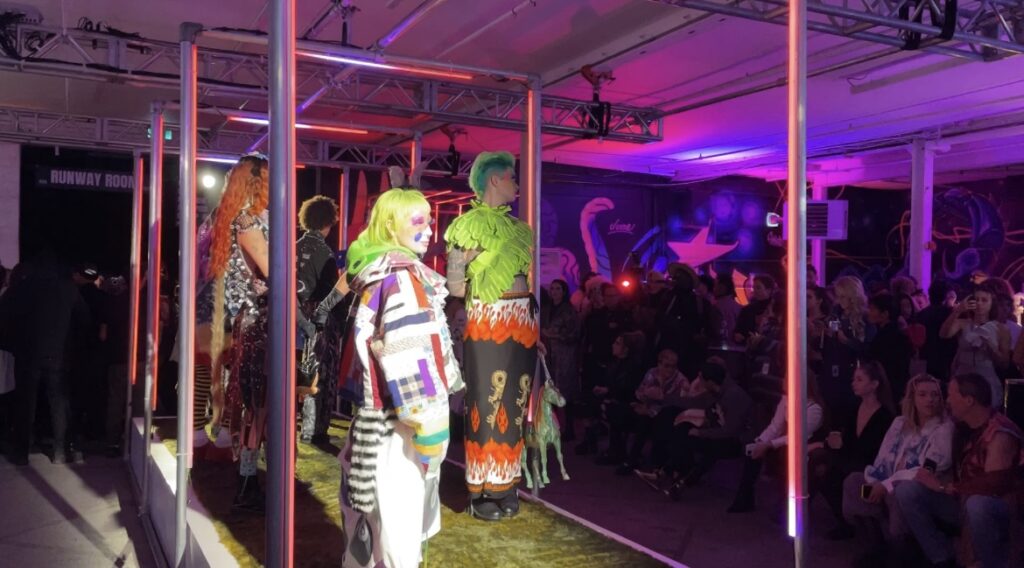By Julia Petrucci

Fashion Art Toronto, Nov 17, 2023 (Julia Petrucci/TMU J-School)
Audio story via Play.ht
There’s an eerie feeling that seeps through each key as I customize an avatar of myself in the digital gaming platform, Roblox. Each rhythmic click of the buttons I press are routinely followed by a new menu of options for me to create my most desired self. I choose to make my hair a cool toned bright pink, I adorn myself in the piercings, makeup and tattoos my avatar can wear, all the things I want to have in the real world but cannot for fear of others’ perceptions.
Most importantly, I choose the clothing I wish to dress in, the layers of myself that people will see first before anything else. With so many options to refine my dream physical form, I am acutely aware of the infinite options of avatar clothing in front of me. It feels dystopian, almost too far-fetched to understand that both traditional and digital designers and gamers have built a world in which we have more opportunities for digital self-expression than we do outside of our laptops.
With the rise of AI and recent expansion of the Metaverse, technology has become embedded into all aspects of our everyday lives. The world of fashion is no exception. Platforms such as Epic Games, Meta, Apple and Google have all made advances to enter the collaborative world of fashion and technology. More recently, Roblox has broken into the fashion industry through both high-end and affordable fashion projects like their collaborations with Gucci, Louis Vuitton, Tommy Hilfiger and Nike. As fashion and technology mesh together to create a broader, more inclusive space for fashion lovers and gamers, what does this mean for the future of fashion?
Roblox is an online game platform and game creation system that was first launched in 2006. It allows users to design their own games for other users as well as play simulations other users have created. Since first launching, the platform has grown into a $26.54 billion dollar industry and revenue has skyrocketed in part due to the increased amount of fashion collaborations in the digital realm.
According to Dune Analytics, Nike has made $185 million through selling non-fungible tokens (NFT’s) through 62.7 thousand digital transactions in the last year alone. Similarly, Roblox is generating profits through digital design making over $655 million in the past year. Although those in the fashion world anticipated the integration and popularity of fashion in gaming platforms, no one expected the industry to explode as quickly as it did.
Daniel Drak, a professor at Parsons School of Design who specializes in the relationship between Gen Z and digital fashion in immersive spaces, predicts the collaborative space between fashion and technology will continue to grow. “There’s no shortage of new things happening constantly in the digital fashion space because this whole industry and these opportunities didn’t even really exist a few years ago. The industry is changing almost day by day, and designers can feel it,” said Drak.
Milena Tomic, a professor at Toronto Metropolitan University and the University of Toronto studies communications and art history. She says that, “after teaching Gen Z about digital art for so long, young people are now becoming the artists instead of just choosing to observe art from afar… so it makes sense that they’re turning to platforms like Roblox to show the world their art.”
This idea is amplified by a study conducted by Roblox and Parsons School of Design which revealed that there are over 200 times as many digital fashion creators on Roblox than there are active fashion designers in the United States. Of that number, over half of the digital designers on the platform are regular gamers on Roblox.
As I continue to play on the platform diving deeper into the digiverse, I can’t help but notice my body leaning forward, my fingers twitching over the keys, and my heartbeat quickening as I go through simulations in the game and eagerly explore this alternate reality. I am being pulled into my laptop screen as I willingly step out of the physical world around me.
This is an effect Drak says much of his research centers around. In the last year, he has worked on the study between Roblox and Parsons to collect data from 1000 Gen Z players on Roblox and get their opinions on how much digital fashion matters to them and where that interest stems from. From those surveyed, 70 per cent reported getting style inspiration from how they present themselves in the game and 20 per cent said self-expression in Roblox is even more important to them than expressing themselves outside the digital space.
The need to explore the metaverse and the pull it has on users due to the potentially limitless market is not lost on fashion designers. “Many old fashion houses pioneering in the metaverse are getting the ‘first mover advantage’ because they are aiming to define the space as their own,” said Drak.
One publication that aims to prioritize showcasing the work of small, independent fashion designers in both the digital and physical realms is Forward Fashion Toronto. The platform was originally intended to be an, “unbiased space to bridge the gap between fashion and the community long before technological integration in fashion,” said the organization’s editor-in-chief, Ugyen Wangmo.
Since launching, Forward has grown into an AI fashion publication releasing both physically produced and AI-generated content for their editions. Since the launch of their most popular edition under Forward AI, the platform has become known for their entirely digital spreads showcasing independent fashion designers and brands. “AI levels the playing field for all creatives, whether it be fashion designers, digital designers and even tech users… Now no one needs a factory to make fashion. AI is that ‘in’ that so many are looking for,” said Wangmo.

Neither Drak, Wangmo or Tomic are concerned about losing the intimate craft of fashion. On the contrary, Wangmo says the artistry is amplified when creatives are brought together from around the world through AI and the inclusivity and diverse perspectives that come with that accessibility. Now, Tomic says young people and creatives should be concerned about how fashion houses and designers are prioritizing profits above all else when creating fashion in the metaverse.
Tomic says, “we live in a world where money making is the number one priority, so this new wave of young designers who are regular people like you and me, bring a new perspective to the fashion and tech industries that we can’t discount.”
As I contently finalize the freckles and blush shade on my perfectly curated digital avatar, I can’t help but think about how my layered baggy jeans, long skirt and fur coat could have all been created by designers my age or younger in their childhood homes. Technology is now giving consumers a new opportunity to style ourselves in pieces that could very well become the next Gucci, Prada and Versace.
For now, they’re all in the metaverse and it’s time we take a step out of the physical world and explore new levels of self-expression through the technology we adore.
